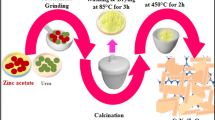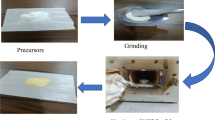Abstract
Homogenous strontium titanate (SrTiO3) nanofibers were prepared via the electrospinning of precursor solutions containing both strontium and titanium salts. Photocatalytic activities of these SrTiO3 nanofibers for hydrogen generation from water were examined and compared to that of SrTiO3 nanoparticles. The nanofibers calcined at 700 °C showed the highest photocatalytic activity of 167 μmol/h/g among the SrTiO3 samples tested. The high activity was attributed to the ideal stoichiometric ratio of Ti/Sr, small crystallite size, high crystallinity, mesoporous structure, large surface area, and appropriate energy gap. These were confirmed through field emission scanning electron microscopic with energy dispersive spectroscopic observations, x-ray diffraction patterns, N2 gas absorption–desorption isotherm measurements, photoelectron yield spectroscopy in air, and UV-visible spectrophotometry.







Similar content being viewed by others
REFERENCES
G.W. Crabtree, M.S. Dresselhaus, and M.V. Buchanan: The hydrogen economy. Phys. Today 57(12), 39 (2004).
A. Fujishima and K. Honda: Electrochemical photolysis of water at a semiconductor electrode. Nature. 238(5358), 37 (1972).
R.U.E. T Lam, L.G.J. de Haart, A.W. Wiersma, G. Blasse, A.H.A. Tinnemans, and A. Mackor: The sensitization of SrTiO3 photoanodes by doping with various transition metal ions. Mater. Res. Bull. 16(12), 1593 (1981).
X. Zhou, J. Shi, and C. Li: Effect of metal doping on electronic structure and visible light absorption of SrTiO3 and NaTaO3 (metal = Mn, Fe, and Co). J. Phys. Chem. A 115(16), 8305 (2011).
M. Ashokkumar: An overview on semiconductor particulate systems for photoproduction of hydrogen. Int. J. Hydrogen Energy 23(6), 427 (1998).
A. Kudo, A. Tanaka, K. Domen, and T. Onishi: The effects of the calcination temperature of SrTiO3 powder on photocatalytic activities. J. Catal. 111(2), 296 (1988).
T. Puangpetch, T. Sreethawong, and S. Chavadej: Hydrogen production over metal-loaded mesoporous-assembled SrTiO3 nanocrystal photocatalysts: Effects of metal type and loading. Int. J. Hydrogen Energy 35(13), 6531 (2010).
J.W. Liu, G. Chen, Z.H. Li, and Z.G. Zhang: Electronic structure and visible light photocatalysis water splitting property of chromium-doped SrTiO3. J. Solid State Chem. 179(12), 3704 (2006).
K. Domen, S. Naito, T. Onishi, and K. Tamaru: Photocatalytic decomposition of liquid water on a NiO-SrTiO3 catalyst. Chem. Phys. Lett. 92(4), 433 (1982).
K. Domen, A. Kudo, T. Onishi, N. Kosugi, and H. Kuroda: Photocatalytic decomposition of water into hydrogen and oxygen over nickel(II) oxide-strontium titanate (SrTiO3) powder. 1. Structure of the catalysts. J. Phys. Chem. 90(2), 292 (1986).
T. Puangpetch, T. Sreethawong, S. Yoshikawa, and S. Chavadej: Hydrogen production from photocatalytic water splitting over mesoporous-assembled SrTiO3 nanocrystal-based photocatalysts. J. Mol. Catal. A: Chem. 312(1–2), 97 (2009).
S. Chuangchote, J. Jitputti, T. Sagawa, and S. Yoshikawa: Photocatalytic activity for hydrogen evolution of electrospun TiO2 nanofibers. ACS Appl. Mater. Interfaces 1(5), 1140 (2009).
L. Macaraig, S. Chuangchote, and T. Sagawa: Fabrication of SrTiO3 nanofibers for hydrogen production. Mater. Res. Soc. Symp. Proc. 1408, (2012).
T. Cao, Y. Li, C. Wang, C. Shao, and Y. Liu: A facile in situ hydrothermal method to SrTiO3/TiO2 nanofiber heterostructures with high photocatalytic activity. Langmuir 27(6), 2946 (2011).
L. Macaraig, S. Chuangchote, and T. Sagawa: Fabrication of strontium titanate nanofibers via electrospinning, in Zero-Carbon Energy Kyoto, Vol. 2012, edited by T. Yao (Springer Verlag, Japan, Tokyo, 2013), p. 141.
A. Guchhait and A.J. Pal: Copper-diffused AgInS2 ternary nanocrystals in hybrid bulk-heterojunction solar cells: Near-infrared active nanophotovoltaics. ACS Appl. Mater. Interfaces 5(10), 4181 (2013).
R. Wongmaneerung, R. Yimnirun, and S. Ananta: Effect of vibro-milling time on phase formation and particle size of lead titanate nanopowders. Mater. Lett. 60(12), 1447 (2006).
V. Subramanian, R.K. Roeder, and E.E. Wolf: Synthesis and UV−visible-light photoactivity of noble-metal−SrTiO3 composites. Ind. Eng. Chem. Res. 45(7), 2187 (2006).
E. Roduner: Size matters: Why nanomaterials are different. Chem. Soc. Rev. 35(7), 583 (2006).
K.S.W. Sing: Reporting physisorption data for gas/solid systems with special reference to the determination of surface area and porosity (Recommendations 1984). Pure Appl. Chem. 57(4), 603 (1985).
Y. Sakatani, D. Grosso, L. Nicole, C. Boissiere, G.J.A.A. de Soler-Illia, and C. Sanchez: Optimised photocatalytic activity of grid-like mesoporous TiO2 films: Effect of crystallinity, pore size distribution, and pore accessibility. J. Mater. Chem. 16(1), 77 (2006).
M.R. Hoffmann, S.T. Martin, W. Choi, and D.W. Bahnemann: Environmental applications of semiconductor photocatalysis. Chem. Rev. 95(1), 69 (1995).
D. Bao, X. Yao, N. Wakiya, K. Shinozaki, and N. Mizutani: Band-gap energies of sol-gel-derived SrTiO3 thin films. Appl. Phy. Lett. 79(23), 3767 (2001).
ACKNOWLEDGMENTS
The authors are indebted to Prof. Keiichi N. Ishihara and Dr. Eiji Yamasue of Graduate School of Energy Science, Kyoto University for the use of TG-DTA apparatus. This work was partly supported by the “Energy Science in the Age of Global Warming” of Global Center of Excellence (G-COE) program (J-051) of the Ministry of Education, Culture, Sports, Science and Technology (MEXT) of Japan.
Author information
Authors and Affiliations
Corresponding author
Supplementary Material
Supplementary Material
Supplementary materials can be viewed in this issue of the Journal of Materials Research by visiting http://journals.cambridge.org/jmr.
Rights and permissions
About this article
Cite this article
Macaraig, L., Chuangchote, S. & Sagawa, T. Electrospun SrTiO3 nanofibers for photocatalytic hydrogen generation. Journal of Materials Research 29, 123–130 (2014). https://doi.org/10.1557/jmr.2013.259
Received:
Accepted:
Published:
Issue Date:
DOI: https://doi.org/10.1557/jmr.2013.259




